First Choice Training: BSBMGT517 Manage Operational Plan Workbook
VerifiedAdded on 2020/04/21
|26
|7315
|103
Homework Assignment
AI Summary
This document is a completed Learner Workbook for the BSBMGT517 Manage Operational Plan unit. It includes a student instruction guide, learner details, and a student checklist. The workbook provides answers to written questions about operational plan resource requirements, consultation processes, and physical resource acquisition. It also outlines alternative approaches to developing key performance indicators and details the steps involved in an induction process. The workbook covers mandatory reading chapters from the textbook, and incorporates case scenarios and project requirements, such as the development of an operational plan and a training plan. The document is designed to assist students in understanding and completing the assessment tasks required for the unit, with a focus on practical application of management principles. The document also includes assessment records and feedback sections.
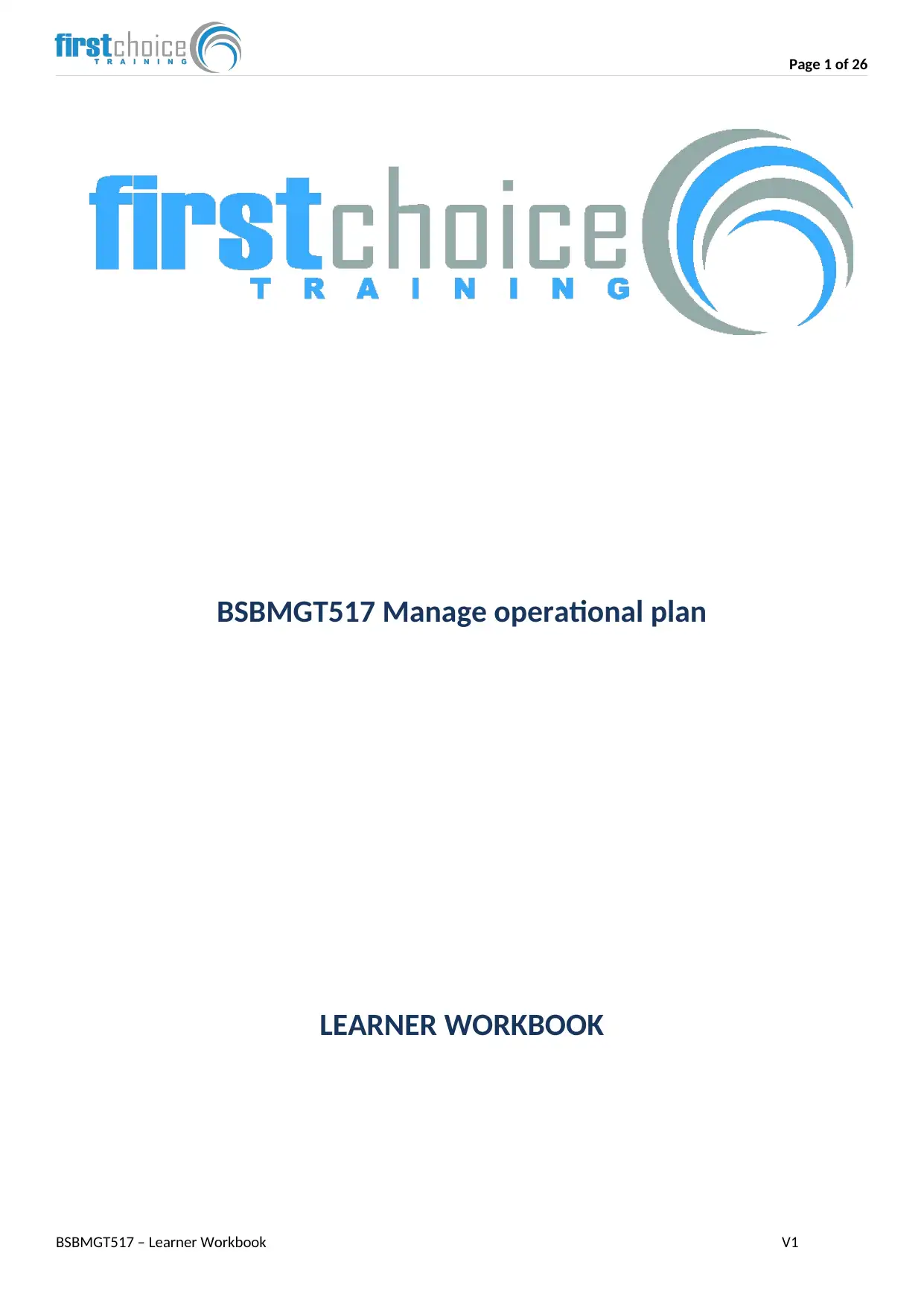
Page 1 of 26
BSBMGT517 Manage operational plan
LEARNER WORKBOOK
BSBMGT517 – Learner Workbook V1
BSBMGT517 Manage operational plan
LEARNER WORKBOOK
BSBMGT517 – Learner Workbook V1
Paraphrase This Document
Need a fresh take? Get an instant paraphrase of this document with our AI Paraphraser
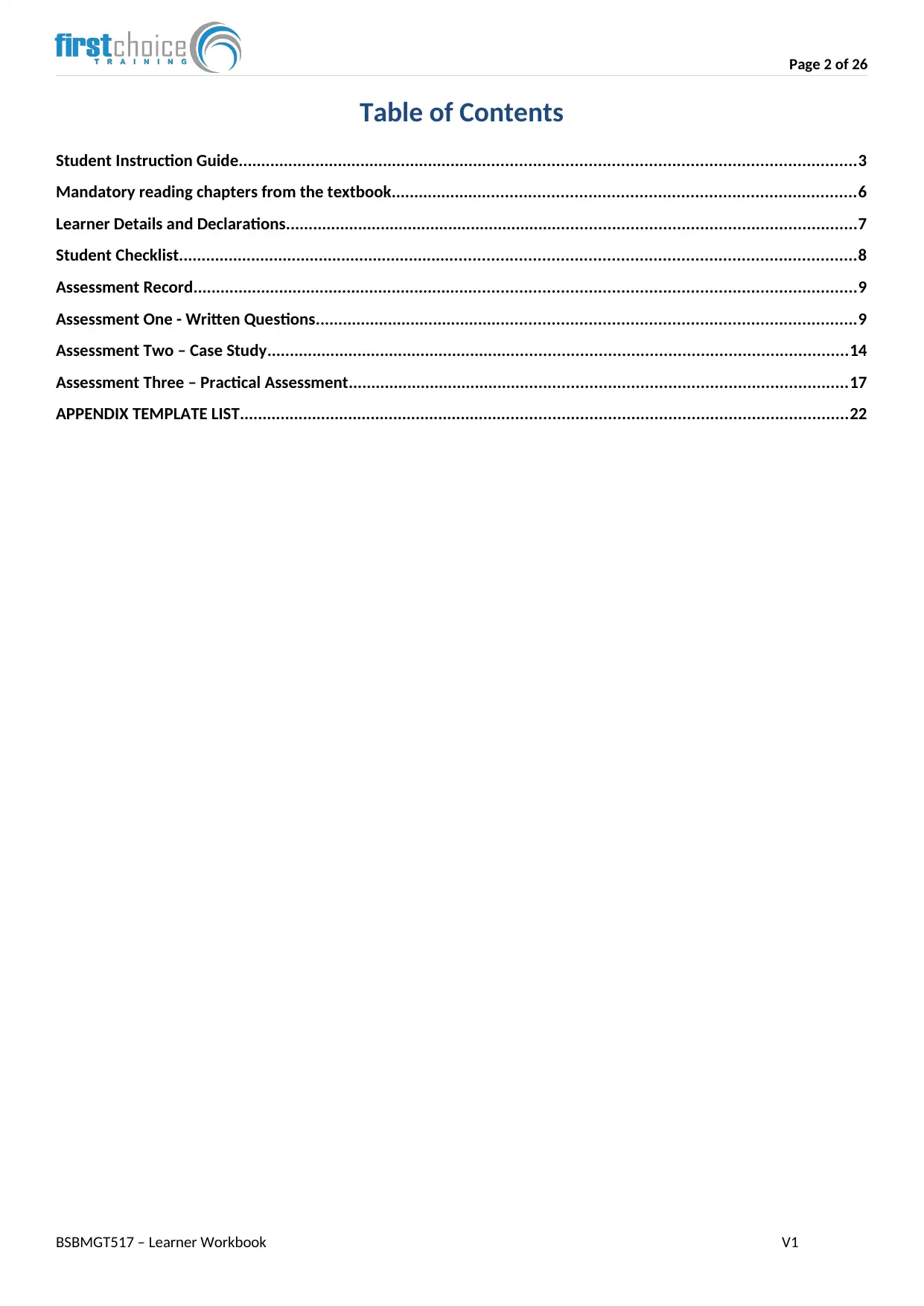
Page 2 of 26
Table of Contents
Student Instruction Guide.......................................................................................................................................3
Mandatory reading chapters from the textbook.....................................................................................................6
Learner Details and Declarations.............................................................................................................................7
Student Checklist....................................................................................................................................................8
Assessment Record.................................................................................................................................................9
Assessment One - Written Questions......................................................................................................................9
Assessment Two – Case Study...............................................................................................................................14
Assessment Three – Practical Assessment.............................................................................................................17
APPENDIX TEMPLATE LIST.....................................................................................................................................22
BSBMGT517 – Learner Workbook V1
Table of Contents
Student Instruction Guide.......................................................................................................................................3
Mandatory reading chapters from the textbook.....................................................................................................6
Learner Details and Declarations.............................................................................................................................7
Student Checklist....................................................................................................................................................8
Assessment Record.................................................................................................................................................9
Assessment One - Written Questions......................................................................................................................9
Assessment Two – Case Study...............................................................................................................................14
Assessment Three – Practical Assessment.............................................................................................................17
APPENDIX TEMPLATE LIST.....................................................................................................................................22
BSBMGT517 – Learner Workbook V1
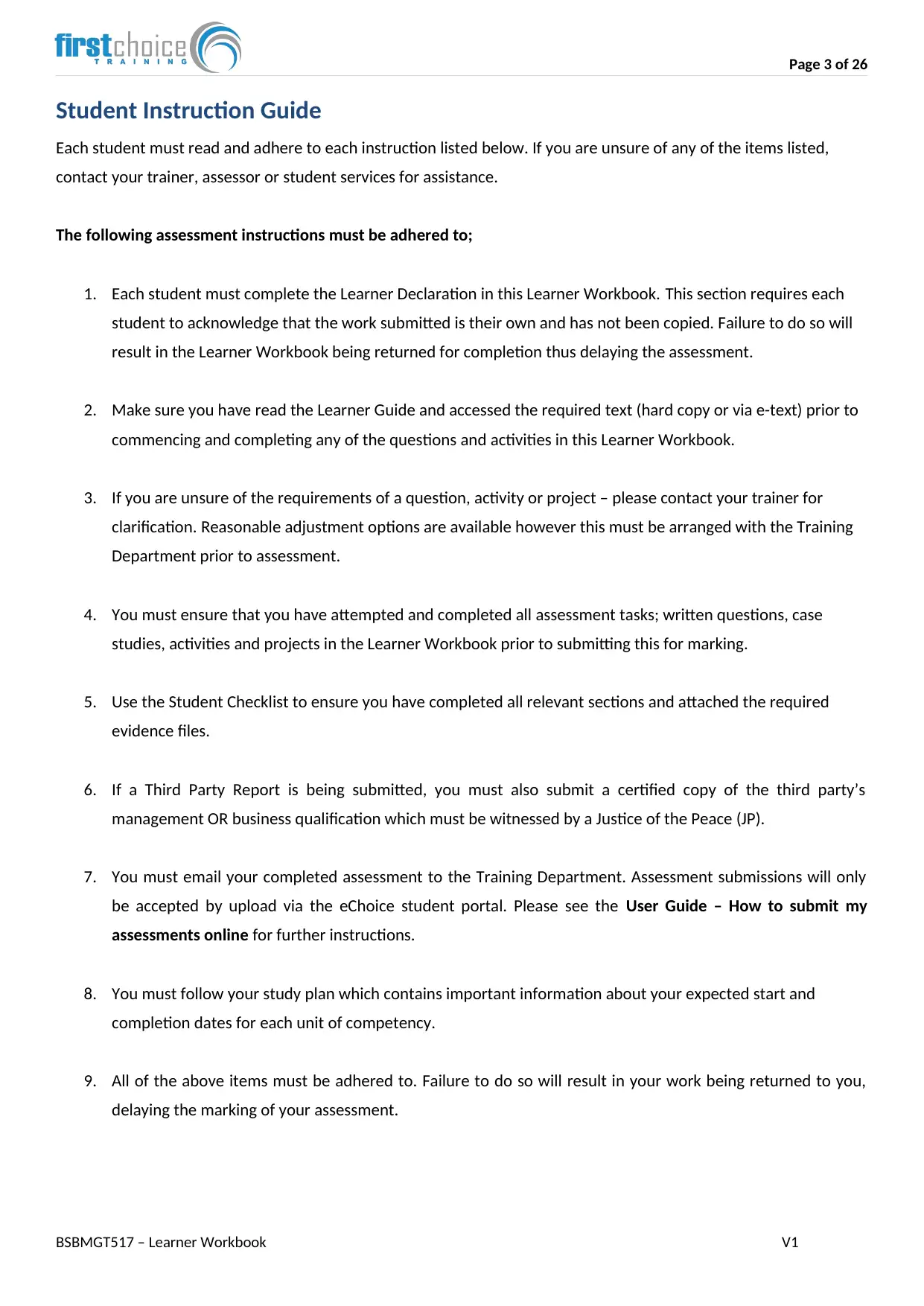
Page 3 of 26
Student Instruction Guide
Each student must read and adhere to each instruction listed below. If you are unsure of any of the items listed,
contact your trainer, assessor or student services for assistance.
The following assessment instructions must be adhered to;
1. Each student must complete the Learner Declaration in this Learner Workbook. This section requires each
student to acknowledge that the work submitted is their own and has not been copied. Failure to do so will
result in the Learner Workbook being returned for completion thus delaying the assessment.
2. Make sure you have read the Learner Guide and accessed the required text (hard copy or via e-text) prior to
commencing and completing any of the questions and activities in this Learner Workbook.
3. If you are unsure of the requirements of a question, activity or project – please contact your trainer for
clarification. Reasonable adjustment options are available however this must be arranged with the Training
Department prior to assessment.
4. You must ensure that you have attempted and completed all assessment tasks; written questions, case
studies, activities and projects in the Learner Workbook prior to submitting this for marking.
5. Use the Student Checklist to ensure you have completed all relevant sections and attached the required
evidence files.
6. If a Third Party Report is being submitted, you must also submit a certified copy of the third party’s
management OR business qualification which must be witnessed by a Justice of the Peace (JP).
7. You must email your completed assessment to the Training Department. Assessment submissions will only
be accepted by upload via the eChoice student portal. Please see the User Guide – How to submit my
assessments online for further instructions.
8. You must follow your study plan which contains important information about your expected start and
completion dates for each unit of competency.
9. All of the above items must be adhered to. Failure to do so will result in your work being returned to you,
delaying the marking of your assessment.
BSBMGT517 – Learner Workbook V1
Student Instruction Guide
Each student must read and adhere to each instruction listed below. If you are unsure of any of the items listed,
contact your trainer, assessor or student services for assistance.
The following assessment instructions must be adhered to;
1. Each student must complete the Learner Declaration in this Learner Workbook. This section requires each
student to acknowledge that the work submitted is their own and has not been copied. Failure to do so will
result in the Learner Workbook being returned for completion thus delaying the assessment.
2. Make sure you have read the Learner Guide and accessed the required text (hard copy or via e-text) prior to
commencing and completing any of the questions and activities in this Learner Workbook.
3. If you are unsure of the requirements of a question, activity or project – please contact your trainer for
clarification. Reasonable adjustment options are available however this must be arranged with the Training
Department prior to assessment.
4. You must ensure that you have attempted and completed all assessment tasks; written questions, case
studies, activities and projects in the Learner Workbook prior to submitting this for marking.
5. Use the Student Checklist to ensure you have completed all relevant sections and attached the required
evidence files.
6. If a Third Party Report is being submitted, you must also submit a certified copy of the third party’s
management OR business qualification which must be witnessed by a Justice of the Peace (JP).
7. You must email your completed assessment to the Training Department. Assessment submissions will only
be accepted by upload via the eChoice student portal. Please see the User Guide – How to submit my
assessments online for further instructions.
8. You must follow your study plan which contains important information about your expected start and
completion dates for each unit of competency.
9. All of the above items must be adhered to. Failure to do so will result in your work being returned to you,
delaying the marking of your assessment.
BSBMGT517 – Learner Workbook V1
⊘ This is a preview!⊘
Do you want full access?
Subscribe today to unlock all pages.

Trusted by 1+ million students worldwide
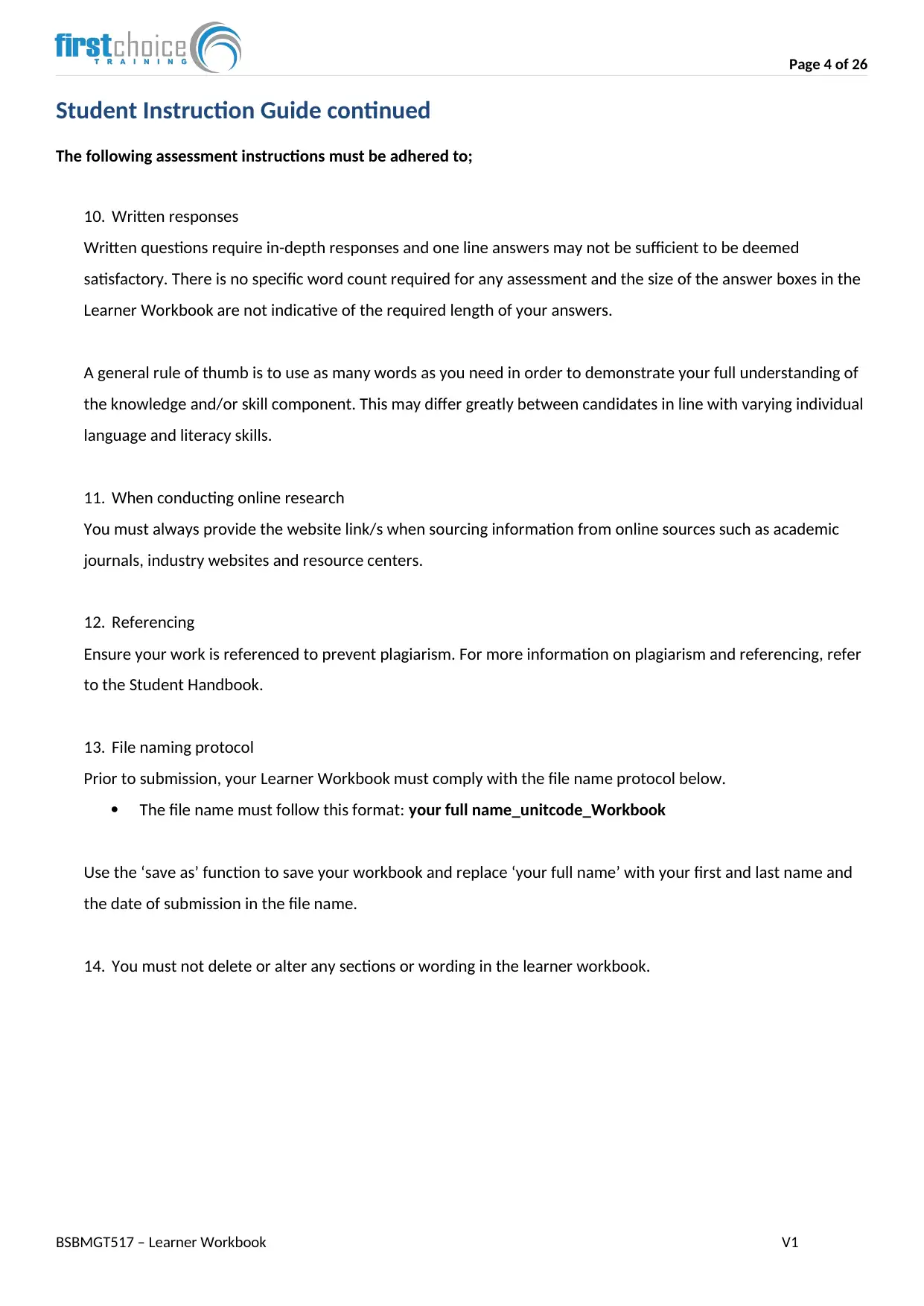
Page 4 of 26
Student Instruction Guide continued
The following assessment instructions must be adhered to;
10. Written responses
Written questions require in-depth responses and one line answers may not be sufficient to be deemed
satisfactory. There is no specific word count required for any assessment and the size of the answer boxes in the
Learner Workbook are not indicative of the required length of your answers.
A general rule of thumb is to use as many words as you need in order to demonstrate your full understanding of
the knowledge and/or skill component. This may differ greatly between candidates in line with varying individual
language and literacy skills.
11. When conducting online research
You must always provide the website link/s when sourcing information from online sources such as academic
journals, industry websites and resource centers.
12. Referencing
Ensure your work is referenced to prevent plagiarism. For more information on plagiarism and referencing, refer
to the Student Handbook.
13. File naming protocol
Prior to submission, your Learner Workbook must comply with the file name protocol below.
The file name must follow this format: your full name_unitcode_Workbook
Use the ‘save as’ function to save your workbook and replace ‘your full name’ with your first and last name and
the date of submission in the file name.
14. You must not delete or alter any sections or wording in the learner workbook.
BSBMGT517 – Learner Workbook V1
Student Instruction Guide continued
The following assessment instructions must be adhered to;
10. Written responses
Written questions require in-depth responses and one line answers may not be sufficient to be deemed
satisfactory. There is no specific word count required for any assessment and the size of the answer boxes in the
Learner Workbook are not indicative of the required length of your answers.
A general rule of thumb is to use as many words as you need in order to demonstrate your full understanding of
the knowledge and/or skill component. This may differ greatly between candidates in line with varying individual
language and literacy skills.
11. When conducting online research
You must always provide the website link/s when sourcing information from online sources such as academic
journals, industry websites and resource centers.
12. Referencing
Ensure your work is referenced to prevent plagiarism. For more information on plagiarism and referencing, refer
to the Student Handbook.
13. File naming protocol
Prior to submission, your Learner Workbook must comply with the file name protocol below.
The file name must follow this format: your full name_unitcode_Workbook
Use the ‘save as’ function to save your workbook and replace ‘your full name’ with your first and last name and
the date of submission in the file name.
14. You must not delete or alter any sections or wording in the learner workbook.
BSBMGT517 – Learner Workbook V1
Paraphrase This Document
Need a fresh take? Get an instant paraphrase of this document with our AI Paraphraser
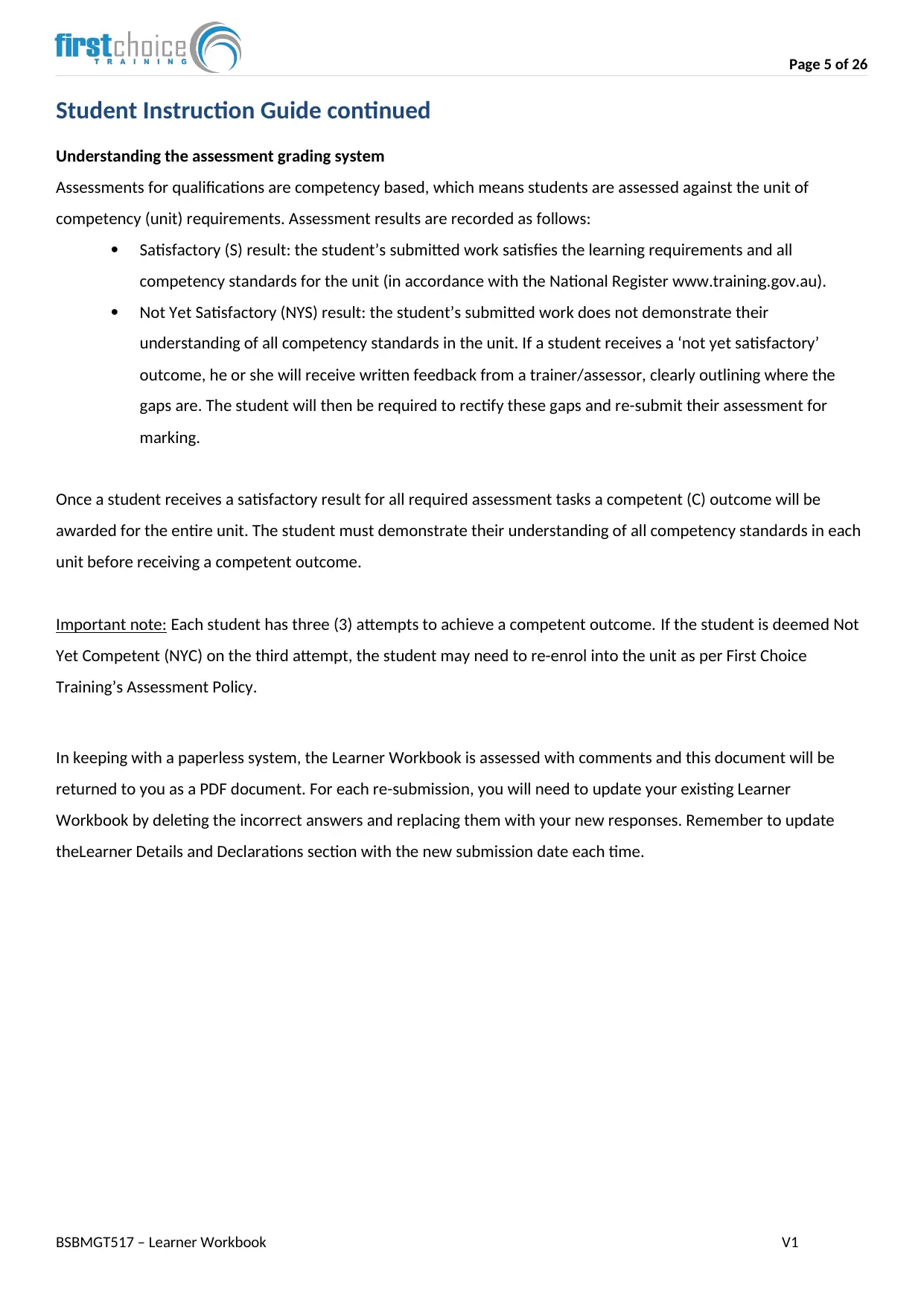
Page 5 of 26
Student Instruction Guide continued
Understanding the assessment grading system
Assessments for qualifications are competency based, which means students are assessed against the unit of
competency (unit) requirements. Assessment results are recorded as follows:
Satisfactory (S) result: the student’s submitted work satisfies the learning requirements and all
competency standards for the unit (in accordance with the National Register www.training.gov.au).
Not Yet Satisfactory (NYS) result: the student’s submitted work does not demonstrate their
understanding of all competency standards in the unit. If a student receives a ‘not yet satisfactory’
outcome, he or she will receive written feedback from a trainer/assessor, clearly outlining where the
gaps are. The student will then be required to rectify these gaps and re-submit their assessment for
marking.
Once a student receives a satisfactory result for all required assessment tasks a competent (C) outcome will be
awarded for the entire unit. The student must demonstrate their understanding of all competency standards in each
unit before receiving a competent outcome.
Important note: Each student has three (3) attempts to achieve a competent outcome. If the student is deemed Not
Yet Competent (NYC) on the third attempt, the student may need to re-enrol into the unit as per First Choice
Training’s Assessment Policy.
In keeping with a paperless system, the Learner Workbook is assessed with comments and this document will be
returned to you as a PDF document. For each re-submission, you will need to update your existing Learner
Workbook by deleting the incorrect answers and replacing them with your new responses. Remember to update
theLearner Details and Declarations section with the new submission date each time.
BSBMGT517 – Learner Workbook V1
Student Instruction Guide continued
Understanding the assessment grading system
Assessments for qualifications are competency based, which means students are assessed against the unit of
competency (unit) requirements. Assessment results are recorded as follows:
Satisfactory (S) result: the student’s submitted work satisfies the learning requirements and all
competency standards for the unit (in accordance with the National Register www.training.gov.au).
Not Yet Satisfactory (NYS) result: the student’s submitted work does not demonstrate their
understanding of all competency standards in the unit. If a student receives a ‘not yet satisfactory’
outcome, he or she will receive written feedback from a trainer/assessor, clearly outlining where the
gaps are. The student will then be required to rectify these gaps and re-submit their assessment for
marking.
Once a student receives a satisfactory result for all required assessment tasks a competent (C) outcome will be
awarded for the entire unit. The student must demonstrate their understanding of all competency standards in each
unit before receiving a competent outcome.
Important note: Each student has three (3) attempts to achieve a competent outcome. If the student is deemed Not
Yet Competent (NYC) on the third attempt, the student may need to re-enrol into the unit as per First Choice
Training’s Assessment Policy.
In keeping with a paperless system, the Learner Workbook is assessed with comments and this document will be
returned to you as a PDF document. For each re-submission, you will need to update your existing Learner
Workbook by deleting the incorrect answers and replacing them with your new responses. Remember to update
theLearner Details and Declarations section with the new submission date each time.
BSBMGT517 – Learner Workbook V1
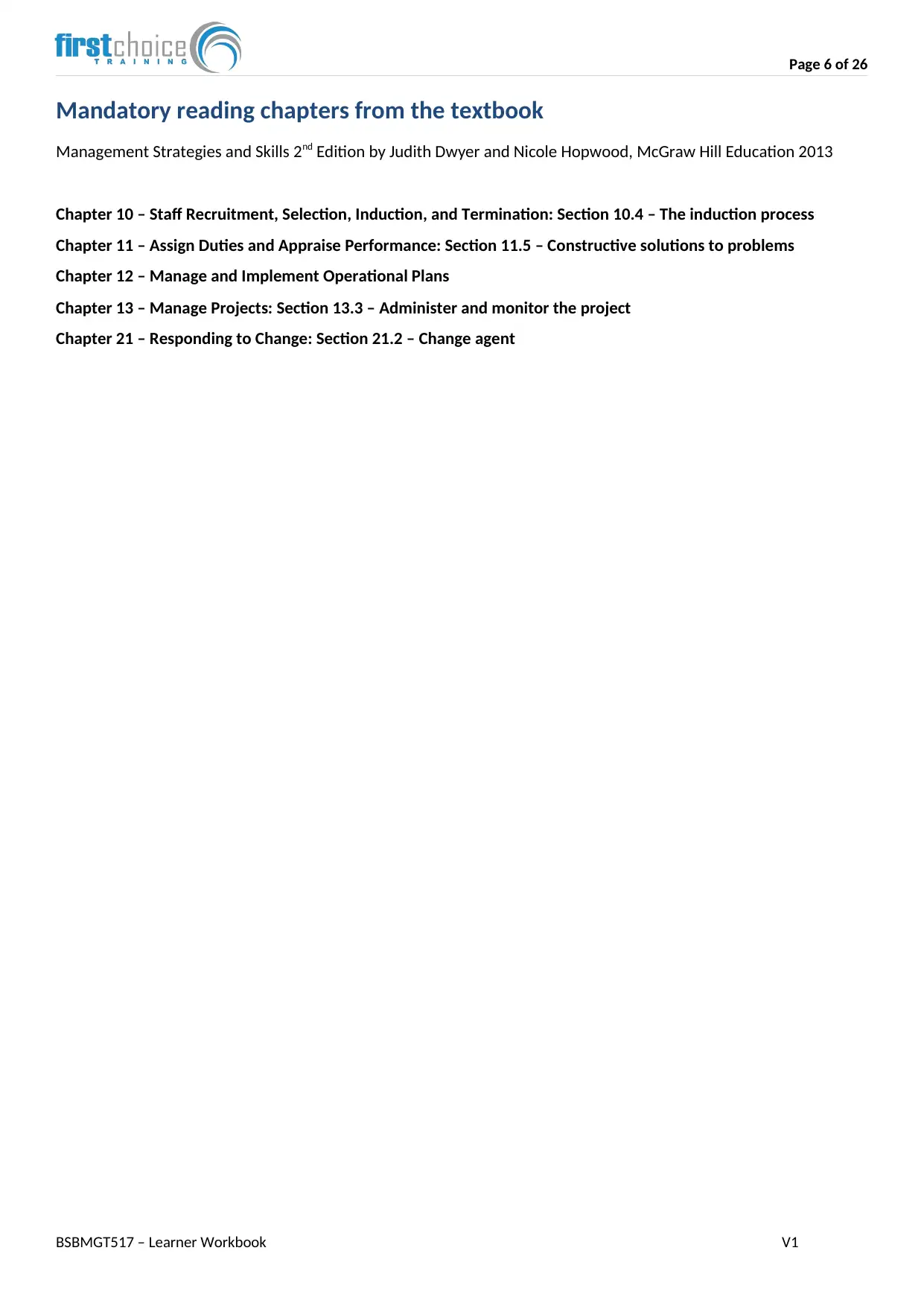
Page 6 of 26
Mandatory reading chapters from the textbook
Management Strategies and Skills 2nd Edition by Judith Dwyer and Nicole Hopwood, McGraw Hill Education 2013
Chapter 10 – Staff Recruitment, Selection, Induction, and Termination: Section 10.4 – The induction process
Chapter 11 – Assign Duties and Appraise Performance: Section 11.5 – Constructive solutions to problems
Chapter 12 – Manage and Implement Operational Plans
Chapter 13 – Manage Projects: Section 13.3 – Administer and monitor the project
Chapter 21 – Responding to Change: Section 21.2 – Change agent
BSBMGT517 – Learner Workbook V1
Mandatory reading chapters from the textbook
Management Strategies and Skills 2nd Edition by Judith Dwyer and Nicole Hopwood, McGraw Hill Education 2013
Chapter 10 – Staff Recruitment, Selection, Induction, and Termination: Section 10.4 – The induction process
Chapter 11 – Assign Duties and Appraise Performance: Section 11.5 – Constructive solutions to problems
Chapter 12 – Manage and Implement Operational Plans
Chapter 13 – Manage Projects: Section 13.3 – Administer and monitor the project
Chapter 21 – Responding to Change: Section 21.2 – Change agent
BSBMGT517 – Learner Workbook V1
⊘ This is a preview!⊘
Do you want full access?
Subscribe today to unlock all pages.

Trusted by 1+ million students worldwide
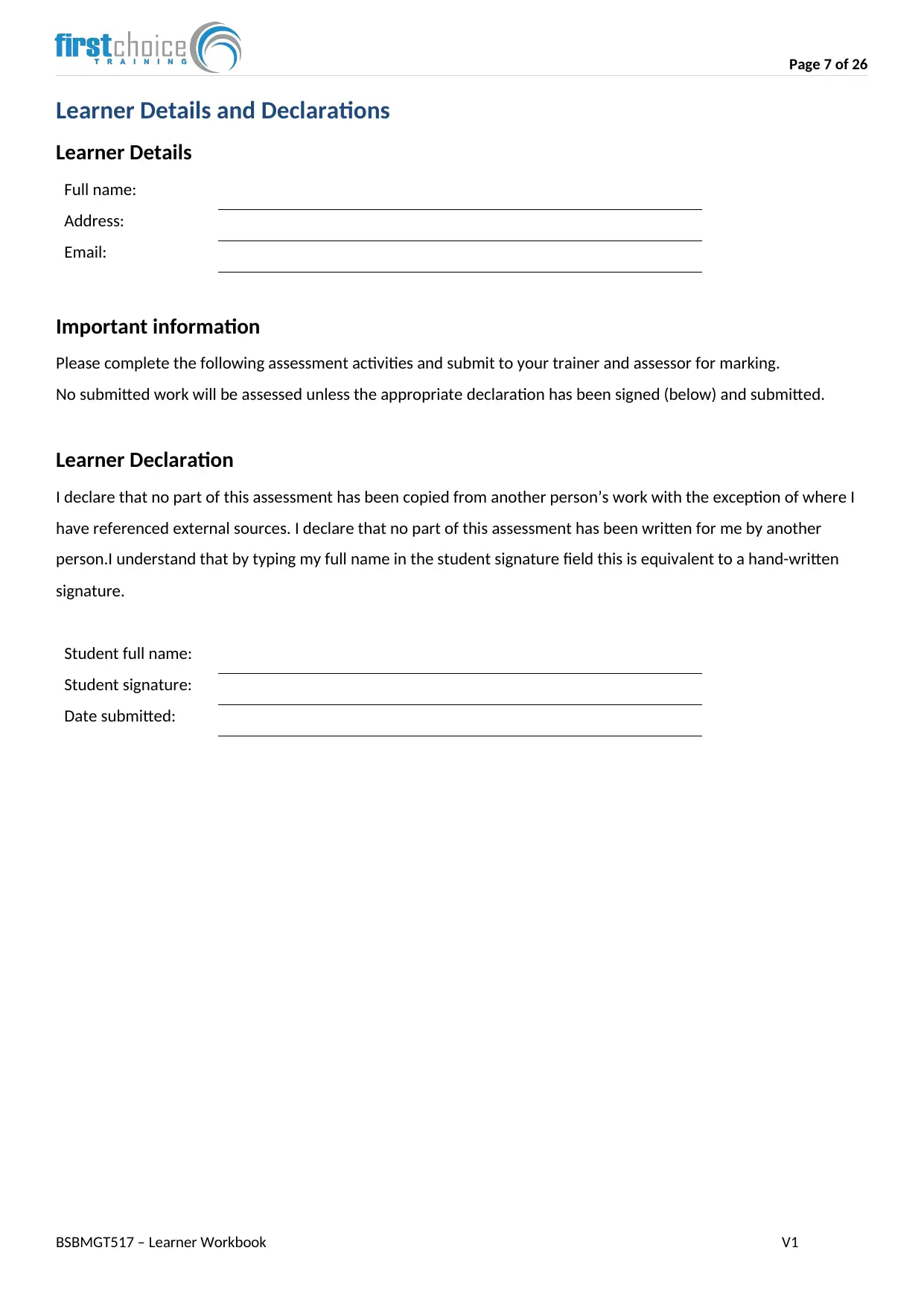
Page 7 of 26
Learner Details and Declarations
Learner Details
Full name:
Address:
Email:
Important information
Please complete the following assessment activities and submit to your trainer and assessor for marking.
No submitted work will be assessed unless the appropriate declaration has been signed (below) and submitted.
Learner Declaration
I declare that no part of this assessment has been copied from another person’s work with the exception of where I
have referenced external sources. I declare that no part of this assessment has been written for me by another
person.I understand that by typing my full name in the student signature field this is equivalent to a hand-written
signature.
Student full name:
Student signature:
Date submitted:
BSBMGT517 – Learner Workbook V1
Learner Details and Declarations
Learner Details
Full name:
Address:
Email:
Important information
Please complete the following assessment activities and submit to your trainer and assessor for marking.
No submitted work will be assessed unless the appropriate declaration has been signed (below) and submitted.
Learner Declaration
I declare that no part of this assessment has been copied from another person’s work with the exception of where I
have referenced external sources. I declare that no part of this assessment has been written for me by another
person.I understand that by typing my full name in the student signature field this is equivalent to a hand-written
signature.
Student full name:
Student signature:
Date submitted:
BSBMGT517 – Learner Workbook V1
Paraphrase This Document
Need a fresh take? Get an instant paraphrase of this document with our AI Paraphraser
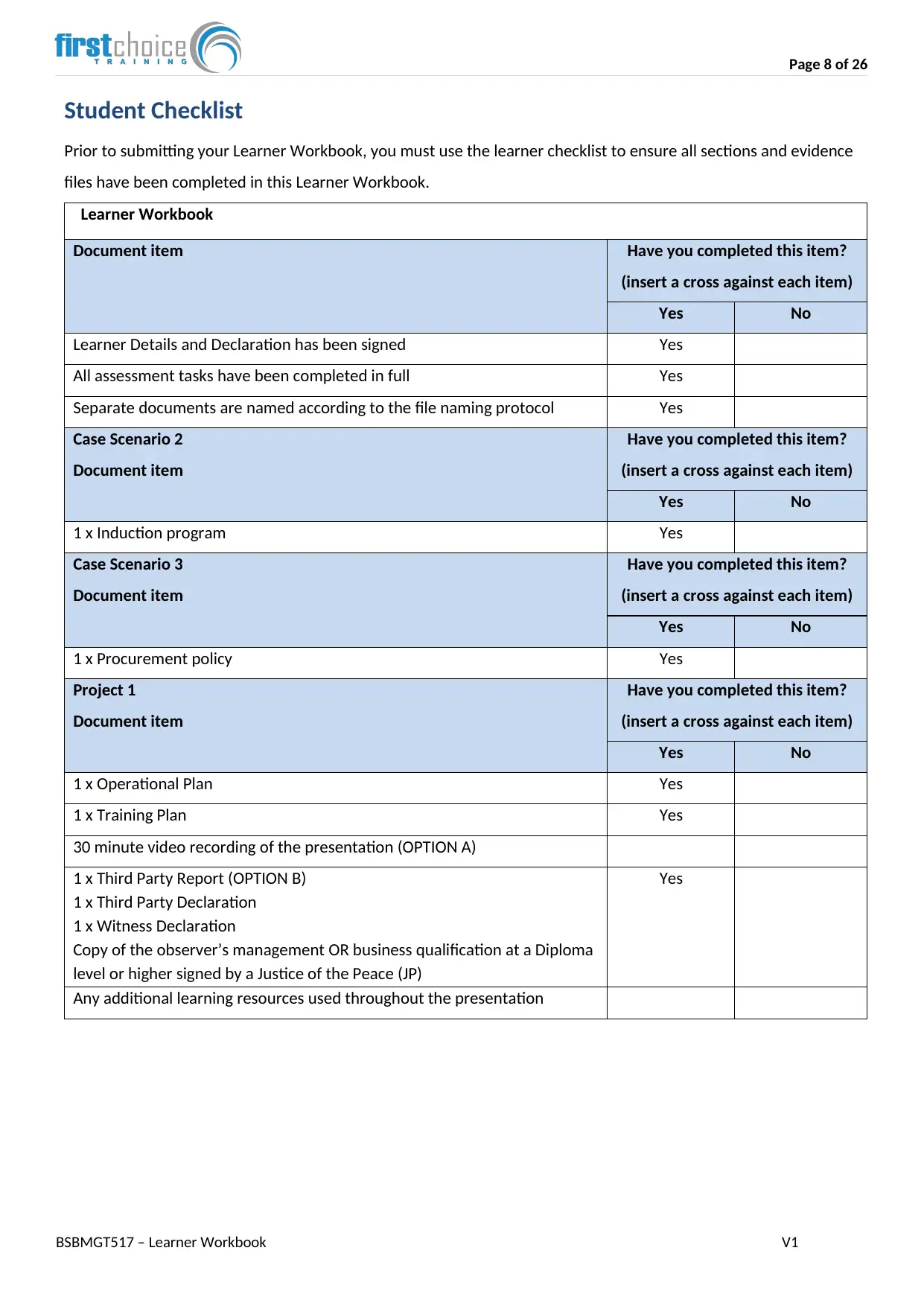
Page 8 of 26
Student Checklist
Prior to submitting your Learner Workbook, you must use the learner checklist to ensure all sections and evidence
files have been completed in this Learner Workbook.
Learner Workbook
Document item Have you completed this item?
(insert a cross against each item)
Yes No
Learner Details and Declaration has been signed Yes
All assessment tasks have been completed in full Yes
Separate documents are named according to the file naming protocol Yes
Case Scenario 2
Document item
Have you completed this item?
(insert a cross against each item)
Yes No
1 x Induction program Yes
Case Scenario 3
Document item
Have you completed this item?
(insert a cross against each item)
Yes No
1 x Procurement policy Yes
Project 1
Document item
Have you completed this item?
(insert a cross against each item)
Yes No
1 x Operational Plan Yes
1 x Training Plan Yes
30 minute video recording of the presentation (OPTION A)
1 x Third Party Report (OPTION B)
1 x Third Party Declaration
1 x Witness Declaration
Copy of the observer’s management OR business qualification at a Diploma
level or higher signed by a Justice of the Peace (JP)
Yes
Any additional learning resources used throughout the presentation
BSBMGT517 – Learner Workbook V1
Student Checklist
Prior to submitting your Learner Workbook, you must use the learner checklist to ensure all sections and evidence
files have been completed in this Learner Workbook.
Learner Workbook
Document item Have you completed this item?
(insert a cross against each item)
Yes No
Learner Details and Declaration has been signed Yes
All assessment tasks have been completed in full Yes
Separate documents are named according to the file naming protocol Yes
Case Scenario 2
Document item
Have you completed this item?
(insert a cross against each item)
Yes No
1 x Induction program Yes
Case Scenario 3
Document item
Have you completed this item?
(insert a cross against each item)
Yes No
1 x Procurement policy Yes
Project 1
Document item
Have you completed this item?
(insert a cross against each item)
Yes No
1 x Operational Plan Yes
1 x Training Plan Yes
30 minute video recording of the presentation (OPTION A)
1 x Third Party Report (OPTION B)
1 x Third Party Declaration
1 x Witness Declaration
Copy of the observer’s management OR business qualification at a Diploma
level or higher signed by a Justice of the Peace (JP)
Yes
Any additional learning resources used throughout the presentation
BSBMGT517 – Learner Workbook V1
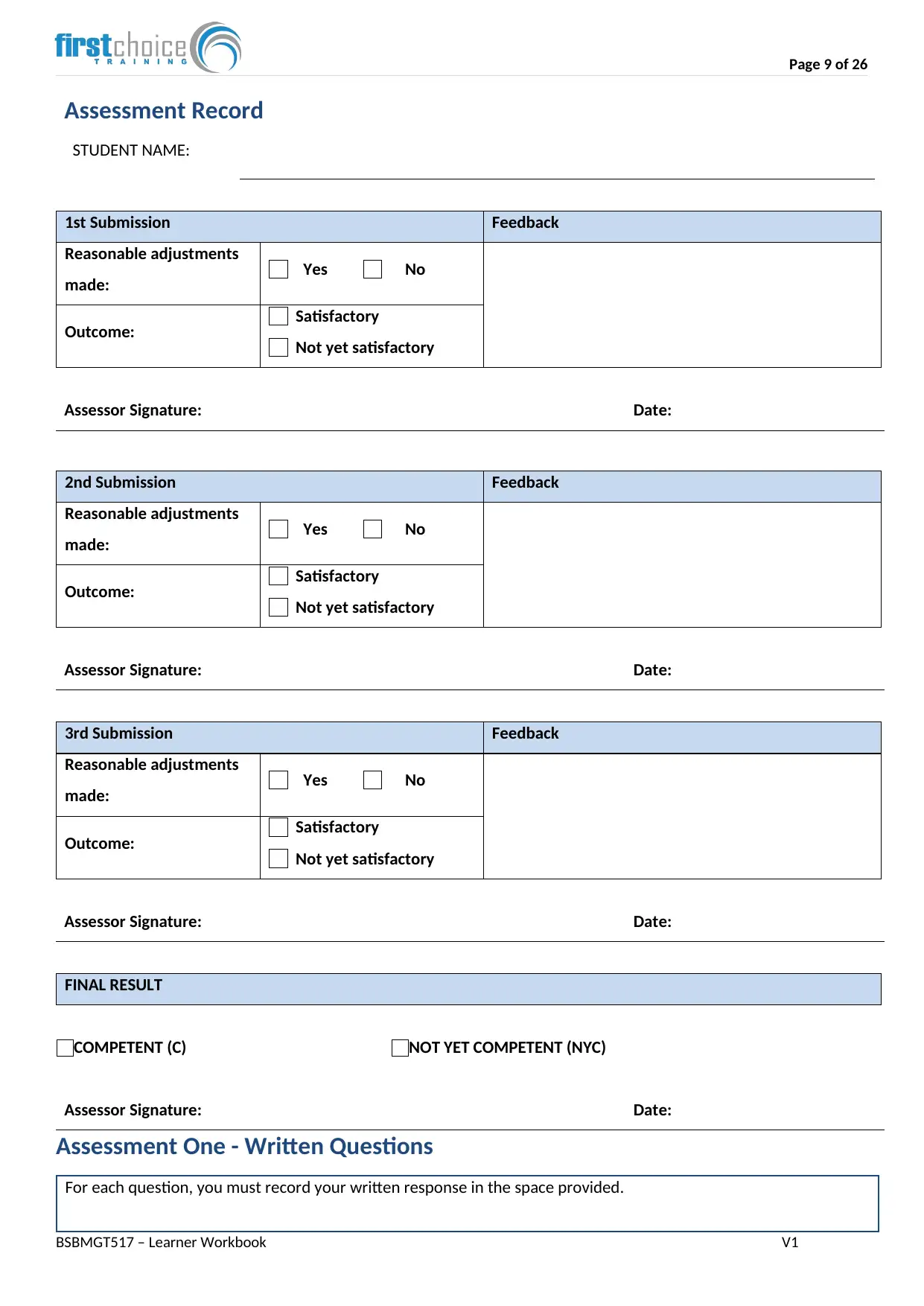
Page 9 of 26
Assessment Record
STUDENT NAME:
1st Submission Feedback
Reasonable adjustments
made: Yes No
Outcome: Satisfactory
Not yet satisfactory
Assessor Signature: Date:
2nd Submission Feedback
Reasonable adjustments
made: Yes No
Outcome: Satisfactory
Not yet satisfactory
Assessor Signature: Date:
3rd Submission Feedback
Reasonable adjustments
made: Yes No
Outcome: Satisfactory
Not yet satisfactory
Assessor Signature: Date:
FINAL RESULT
COMPETENT (C) NOT YET COMPETENT (NYC)
Assessor Signature: Date:
Assessment One - Written Questions
For each question, you must record your written response in the space provided.
BSBMGT517 – Learner Workbook V1
Assessment Record
STUDENT NAME:
1st Submission Feedback
Reasonable adjustments
made: Yes No
Outcome: Satisfactory
Not yet satisfactory
Assessor Signature: Date:
2nd Submission Feedback
Reasonable adjustments
made: Yes No
Outcome: Satisfactory
Not yet satisfactory
Assessor Signature: Date:
3rd Submission Feedback
Reasonable adjustments
made: Yes No
Outcome: Satisfactory
Not yet satisfactory
Assessor Signature: Date:
FINAL RESULT
COMPETENT (C) NOT YET COMPETENT (NYC)
Assessor Signature: Date:
Assessment One - Written Questions
For each question, you must record your written response in the space provided.
BSBMGT517 – Learner Workbook V1
⊘ This is a preview!⊘
Do you want full access?
Subscribe today to unlock all pages.

Trusted by 1+ million students worldwide
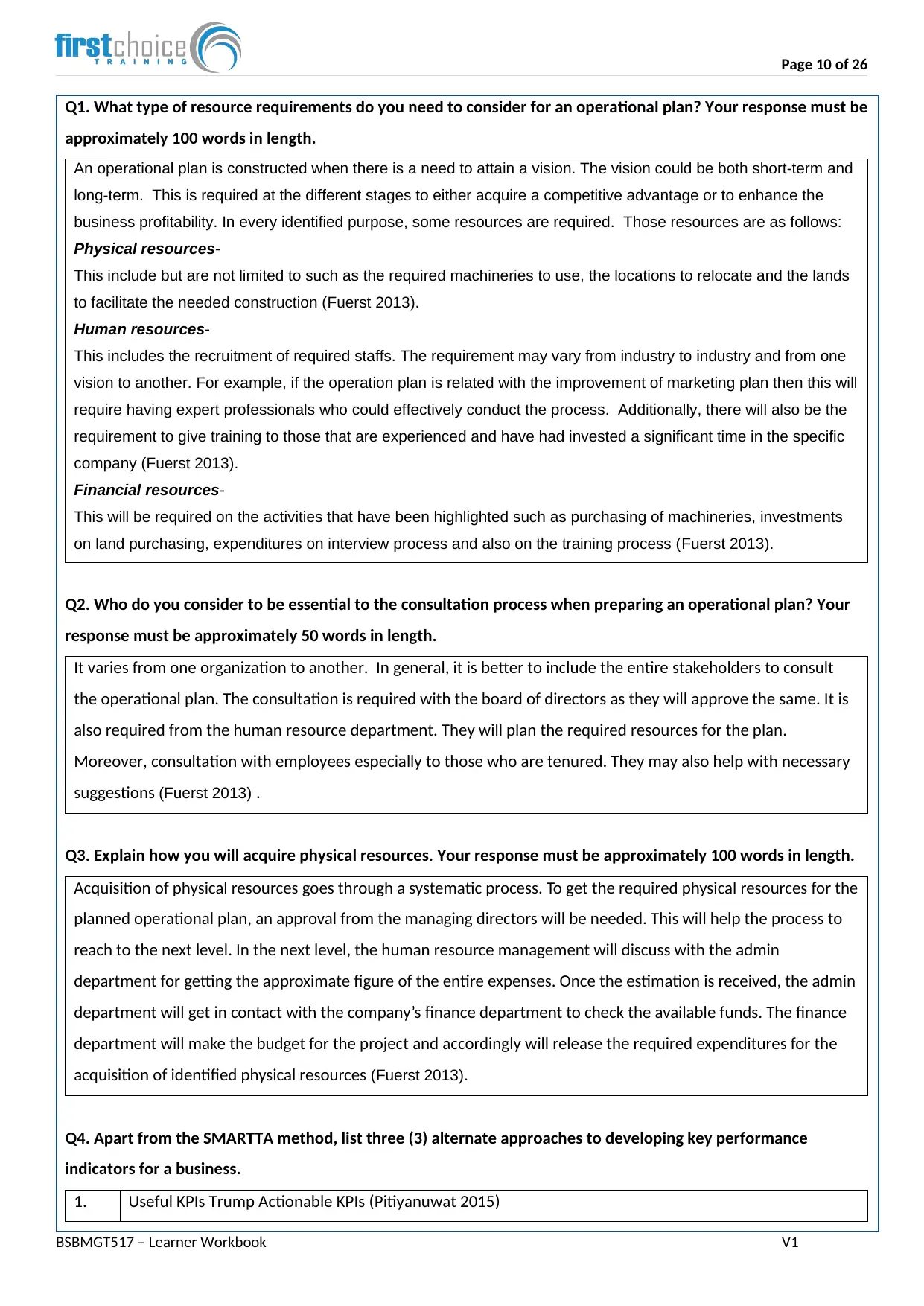
Page 10 of 26
Q1. What type of resource requirements do you need to consider for an operational plan? Your response must be
approximately 100 words in length.
An operational plan is constructed when there is a need to attain a vision. The vision could be both short-term and
long-term. This is required at the different stages to either acquire a competitive advantage or to enhance the
business profitability. In every identified purpose, some resources are required. Those resources are as follows:
Physical resources-
This include but are not limited to such as the required machineries to use, the locations to relocate and the lands
to facilitate the needed construction (Fuerst 2013).
Human resources-
This includes the recruitment of required staffs. The requirement may vary from industry to industry and from one
vision to another. For example, if the operation plan is related with the improvement of marketing plan then this will
require having expert professionals who could effectively conduct the process. Additionally, there will also be the
requirement to give training to those that are experienced and have had invested a significant time in the specific
company (Fuerst 2013).
Financial resources-
This will be required on the activities that have been highlighted such as purchasing of machineries, investments
on land purchasing, expenditures on interview process and also on the training process (Fuerst 2013).
Q2. Who do you consider to be essential to the consultation process when preparing an operational plan? Your
response must be approximately 50 words in length.
It varies from one organization to another. In general, it is better to include the entire stakeholders to consult
the operational plan. The consultation is required with the board of directors as they will approve the same. It is
also required from the human resource department. They will plan the required resources for the plan.
Moreover, consultation with employees especially to those who are tenured. They may also help with necessary
suggestions (Fuerst 2013) .
Q3. Explain how you will acquire physical resources. Your response must be approximately 100 words in length.
Acquisition of physical resources goes through a systematic process. To get the required physical resources for the
planned operational plan, an approval from the managing directors will be needed. This will help the process to
reach to the next level. In the next level, the human resource management will discuss with the admin
department for getting the approximate figure of the entire expenses. Once the estimation is received, the admin
department will get in contact with the company’s finance department to check the available funds. The finance
department will make the budget for the project and accordingly will release the required expenditures for the
acquisition of identified physical resources (Fuerst 2013).
Q4. Apart from the SMARTTA method, list three (3) alternate approaches to developing key performance
indicators for a business.
1. Useful KPIs Trump Actionable KPIs (Pitiyanuwat 2015)
BSBMGT517 – Learner Workbook V1
Q1. What type of resource requirements do you need to consider for an operational plan? Your response must be
approximately 100 words in length.
An operational plan is constructed when there is a need to attain a vision. The vision could be both short-term and
long-term. This is required at the different stages to either acquire a competitive advantage or to enhance the
business profitability. In every identified purpose, some resources are required. Those resources are as follows:
Physical resources-
This include but are not limited to such as the required machineries to use, the locations to relocate and the lands
to facilitate the needed construction (Fuerst 2013).
Human resources-
This includes the recruitment of required staffs. The requirement may vary from industry to industry and from one
vision to another. For example, if the operation plan is related with the improvement of marketing plan then this will
require having expert professionals who could effectively conduct the process. Additionally, there will also be the
requirement to give training to those that are experienced and have had invested a significant time in the specific
company (Fuerst 2013).
Financial resources-
This will be required on the activities that have been highlighted such as purchasing of machineries, investments
on land purchasing, expenditures on interview process and also on the training process (Fuerst 2013).
Q2. Who do you consider to be essential to the consultation process when preparing an operational plan? Your
response must be approximately 50 words in length.
It varies from one organization to another. In general, it is better to include the entire stakeholders to consult
the operational plan. The consultation is required with the board of directors as they will approve the same. It is
also required from the human resource department. They will plan the required resources for the plan.
Moreover, consultation with employees especially to those who are tenured. They may also help with necessary
suggestions (Fuerst 2013) .
Q3. Explain how you will acquire physical resources. Your response must be approximately 100 words in length.
Acquisition of physical resources goes through a systematic process. To get the required physical resources for the
planned operational plan, an approval from the managing directors will be needed. This will help the process to
reach to the next level. In the next level, the human resource management will discuss with the admin
department for getting the approximate figure of the entire expenses. Once the estimation is received, the admin
department will get in contact with the company’s finance department to check the available funds. The finance
department will make the budget for the project and accordingly will release the required expenditures for the
acquisition of identified physical resources (Fuerst 2013).
Q4. Apart from the SMARTTA method, list three (3) alternate approaches to developing key performance
indicators for a business.
1. Useful KPIs Trump Actionable KPIs (Pitiyanuwat 2015)
BSBMGT517 – Learner Workbook V1
Paraphrase This Document
Need a fresh take? Get an instant paraphrase of this document with our AI Paraphraser
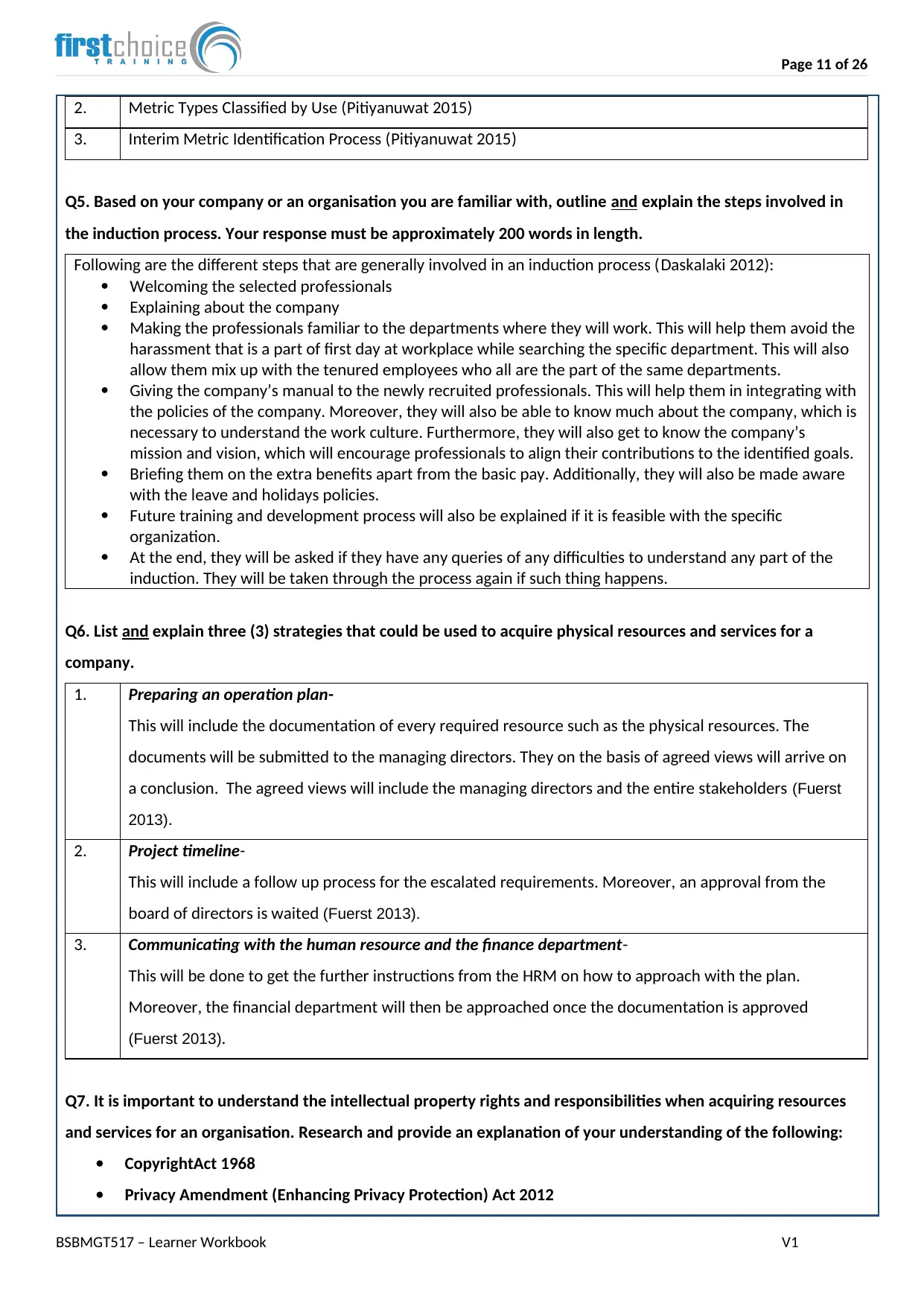
Page 11 of 26
2. Metric Types Classified by Use (Pitiyanuwat 2015)
3. Interim Metric Identification Process (Pitiyanuwat 2015)
Q5. Based on your company or an organisation you are familiar with, outline and explain the steps involved in
the induction process. Your response must be approximately 200 words in length.
Following are the different steps that are generally involved in an induction process (Daskalaki 2012):
Welcoming the selected professionals
Explaining about the company
Making the professionals familiar to the departments where they will work. This will help them avoid the
harassment that is a part of first day at workplace while searching the specific department. This will also
allow them mix up with the tenured employees who all are the part of the same departments.
Giving the company’s manual to the newly recruited professionals. This will help them in integrating with
the policies of the company. Moreover, they will also be able to know much about the company, which is
necessary to understand the work culture. Furthermore, they will also get to know the company’s
mission and vision, which will encourage professionals to align their contributions to the identified goals.
Briefing them on the extra benefits apart from the basic pay. Additionally, they will also be made aware
with the leave and holidays policies.
Future training and development process will also be explained if it is feasible with the specific
organization.
At the end, they will be asked if they have any queries of any difficulties to understand any part of the
induction. They will be taken through the process again if such thing happens.
Q6. List and explain three (3) strategies that could be used to acquire physical resources and services for a
company.
1. Preparing an operation plan-
This will include the documentation of every required resource such as the physical resources. The
documents will be submitted to the managing directors. They on the basis of agreed views will arrive on
a conclusion. The agreed views will include the managing directors and the entire stakeholders (Fuerst
2013).
2. Project timeline-
This will include a follow up process for the escalated requirements. Moreover, an approval from the
board of directors is waited (Fuerst 2013).
3. Communicating with the human resource and the finance department-
This will be done to get the further instructions from the HRM on how to approach with the plan.
Moreover, the financial department will then be approached once the documentation is approved
(Fuerst 2013).
Q7. It is important to understand the intellectual property rights and responsibilities when acquiring resources
and services for an organisation. Research and provide an explanation of your understanding of the following:
CopyrightAct 1968
Privacy Amendment (Enhancing Privacy Protection) Act 2012
BSBMGT517 – Learner Workbook V1
2. Metric Types Classified by Use (Pitiyanuwat 2015)
3. Interim Metric Identification Process (Pitiyanuwat 2015)
Q5. Based on your company or an organisation you are familiar with, outline and explain the steps involved in
the induction process. Your response must be approximately 200 words in length.
Following are the different steps that are generally involved in an induction process (Daskalaki 2012):
Welcoming the selected professionals
Explaining about the company
Making the professionals familiar to the departments where they will work. This will help them avoid the
harassment that is a part of first day at workplace while searching the specific department. This will also
allow them mix up with the tenured employees who all are the part of the same departments.
Giving the company’s manual to the newly recruited professionals. This will help them in integrating with
the policies of the company. Moreover, they will also be able to know much about the company, which is
necessary to understand the work culture. Furthermore, they will also get to know the company’s
mission and vision, which will encourage professionals to align their contributions to the identified goals.
Briefing them on the extra benefits apart from the basic pay. Additionally, they will also be made aware
with the leave and holidays policies.
Future training and development process will also be explained if it is feasible with the specific
organization.
At the end, they will be asked if they have any queries of any difficulties to understand any part of the
induction. They will be taken through the process again if such thing happens.
Q6. List and explain three (3) strategies that could be used to acquire physical resources and services for a
company.
1. Preparing an operation plan-
This will include the documentation of every required resource such as the physical resources. The
documents will be submitted to the managing directors. They on the basis of agreed views will arrive on
a conclusion. The agreed views will include the managing directors and the entire stakeholders (Fuerst
2013).
2. Project timeline-
This will include a follow up process for the escalated requirements. Moreover, an approval from the
board of directors is waited (Fuerst 2013).
3. Communicating with the human resource and the finance department-
This will be done to get the further instructions from the HRM on how to approach with the plan.
Moreover, the financial department will then be approached once the documentation is approved
(Fuerst 2013).
Q7. It is important to understand the intellectual property rights and responsibilities when acquiring resources
and services for an organisation. Research and provide an explanation of your understanding of the following:
CopyrightAct 1968
Privacy Amendment (Enhancing Privacy Protection) Act 2012
BSBMGT517 – Learner Workbook V1
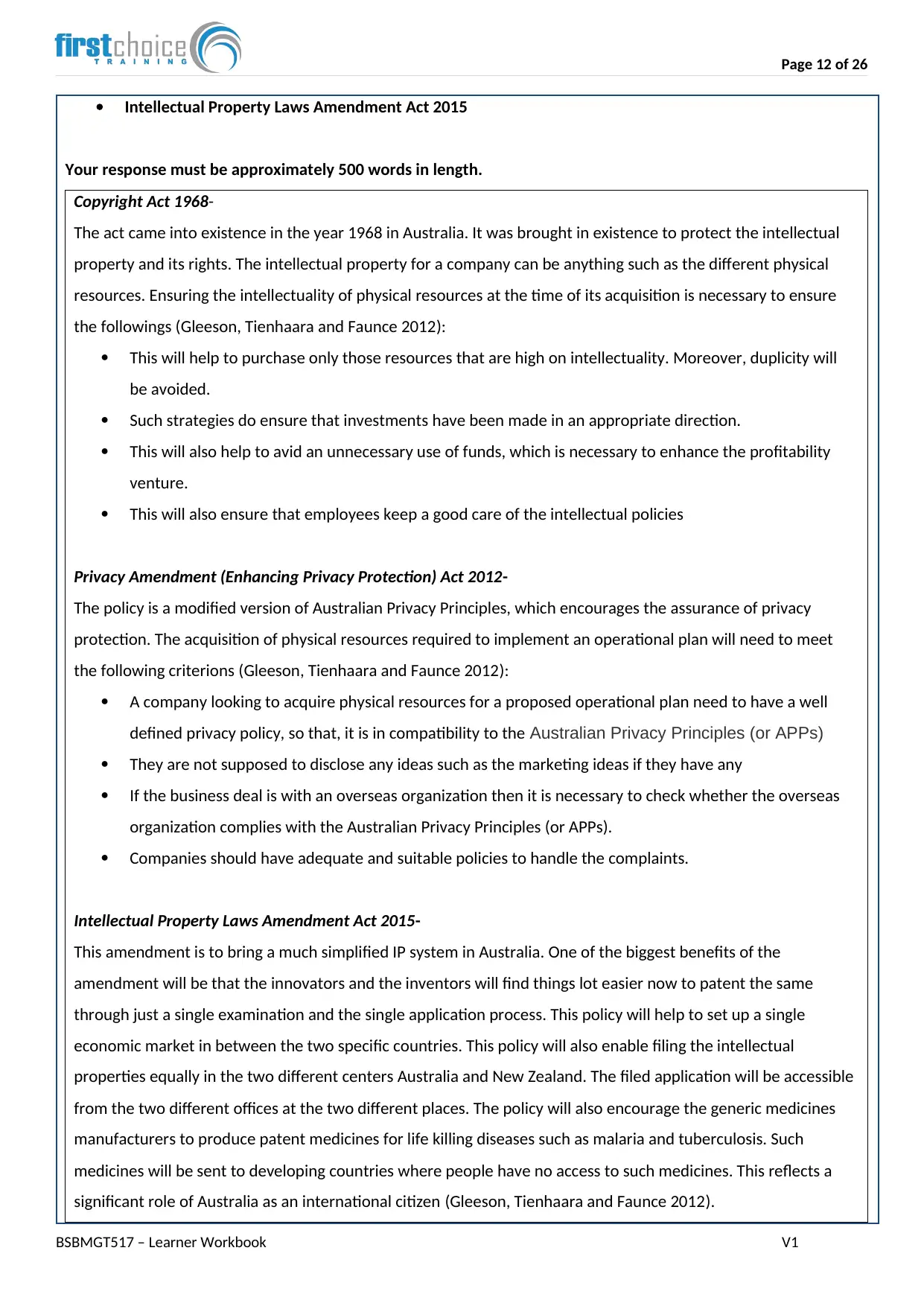
Page 12 of 26
Intellectual Property Laws Amendment Act 2015
Your response must be approximately 500 words in length.
Copyright Act 1968-
The act came into existence in the year 1968 in Australia. It was brought in existence to protect the intellectual
property and its rights. The intellectual property for a company can be anything such as the different physical
resources. Ensuring the intellectuality of physical resources at the time of its acquisition is necessary to ensure
the followings (Gleeson, Tienhaara and Faunce 2012):
This will help to purchase only those resources that are high on intellectuality. Moreover, duplicity will
be avoided.
Such strategies do ensure that investments have been made in an appropriate direction.
This will also help to avid an unnecessary use of funds, which is necessary to enhance the profitability
venture.
This will also ensure that employees keep a good care of the intellectual policies
Privacy Amendment (Enhancing Privacy Protection) Act 2012-
The policy is a modified version of Australian Privacy Principles, which encourages the assurance of privacy
protection. The acquisition of physical resources required to implement an operational plan will need to meet
the following criterions (Gleeson, Tienhaara and Faunce 2012):
A company looking to acquire physical resources for a proposed operational plan need to have a well
defined privacy policy, so that, it is in compatibility to the Australian Privacy Principles (or APPs)
They are not supposed to disclose any ideas such as the marketing ideas if they have any
If the business deal is with an overseas organization then it is necessary to check whether the overseas
organization complies with the Australian Privacy Principles (or APPs).
Companies should have adequate and suitable policies to handle the complaints.
Intellectual Property Laws Amendment Act 2015-
This amendment is to bring a much simplified IP system in Australia. One of the biggest benefits of the
amendment will be that the innovators and the inventors will find things lot easier now to patent the same
through just a single examination and the single application process. This policy will help to set up a single
economic market in between the two specific countries. This policy will also enable filing the intellectual
properties equally in the two different centers Australia and New Zealand. The filed application will be accessible
from the two different offices at the two different places. The policy will also encourage the generic medicines
manufacturers to produce patent medicines for life killing diseases such as malaria and tuberculosis. Such
medicines will be sent to developing countries where people have no access to such medicines. This reflects a
significant role of Australia as an international citizen (Gleeson, Tienhaara and Faunce 2012).
BSBMGT517 – Learner Workbook V1
Intellectual Property Laws Amendment Act 2015
Your response must be approximately 500 words in length.
Copyright Act 1968-
The act came into existence in the year 1968 in Australia. It was brought in existence to protect the intellectual
property and its rights. The intellectual property for a company can be anything such as the different physical
resources. Ensuring the intellectuality of physical resources at the time of its acquisition is necessary to ensure
the followings (Gleeson, Tienhaara and Faunce 2012):
This will help to purchase only those resources that are high on intellectuality. Moreover, duplicity will
be avoided.
Such strategies do ensure that investments have been made in an appropriate direction.
This will also help to avid an unnecessary use of funds, which is necessary to enhance the profitability
venture.
This will also ensure that employees keep a good care of the intellectual policies
Privacy Amendment (Enhancing Privacy Protection) Act 2012-
The policy is a modified version of Australian Privacy Principles, which encourages the assurance of privacy
protection. The acquisition of physical resources required to implement an operational plan will need to meet
the following criterions (Gleeson, Tienhaara and Faunce 2012):
A company looking to acquire physical resources for a proposed operational plan need to have a well
defined privacy policy, so that, it is in compatibility to the Australian Privacy Principles (or APPs)
They are not supposed to disclose any ideas such as the marketing ideas if they have any
If the business deal is with an overseas organization then it is necessary to check whether the overseas
organization complies with the Australian Privacy Principles (or APPs).
Companies should have adequate and suitable policies to handle the complaints.
Intellectual Property Laws Amendment Act 2015-
This amendment is to bring a much simplified IP system in Australia. One of the biggest benefits of the
amendment will be that the innovators and the inventors will find things lot easier now to patent the same
through just a single examination and the single application process. This policy will help to set up a single
economic market in between the two specific countries. This policy will also enable filing the intellectual
properties equally in the two different centers Australia and New Zealand. The filed application will be accessible
from the two different offices at the two different places. The policy will also encourage the generic medicines
manufacturers to produce patent medicines for life killing diseases such as malaria and tuberculosis. Such
medicines will be sent to developing countries where people have no access to such medicines. This reflects a
significant role of Australia as an international citizen (Gleeson, Tienhaara and Faunce 2012).
BSBMGT517 – Learner Workbook V1
⊘ This is a preview!⊘
Do you want full access?
Subscribe today to unlock all pages.

Trusted by 1+ million students worldwide
1 out of 26
Related Documents
Your All-in-One AI-Powered Toolkit for Academic Success.
+13062052269
info@desklib.com
Available 24*7 on WhatsApp / Email
![[object Object]](/_next/static/media/star-bottom.7253800d.svg)
Unlock your academic potential
Copyright © 2020–2025 A2Z Services. All Rights Reserved. Developed and managed by ZUCOL.





